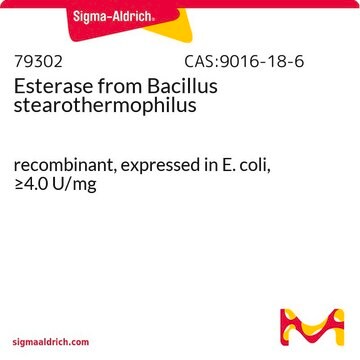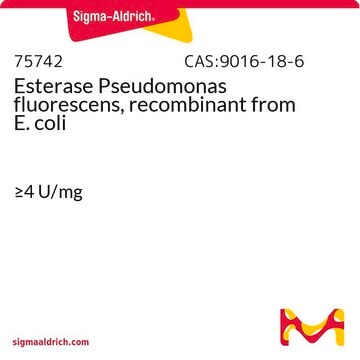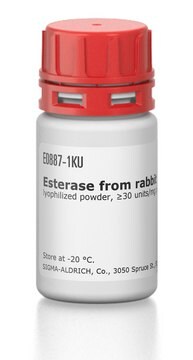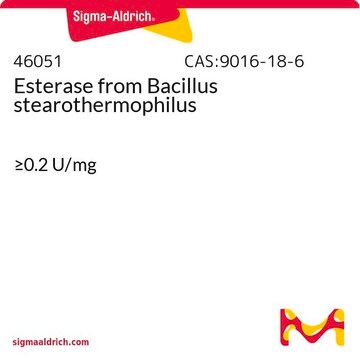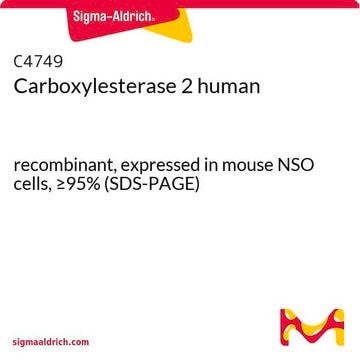96667
Esterase from Bacillus subtilis
recombinant, expressed in E. coli, ≥10 U/mg
Synonym(s):
Carboxylesterase
Sign Into View Organizational & Contract Pricing
All Photos(1)
About This Item
Recommended Products
recombinant
expressed in E. coli
form
crystalline
crystals
powder or flakes
specific activity
≥10 U/mg
storage temp.
−20°C
Looking for similar products? Visit Product Comparison Guide
General description
Esterase belongs to the hydrolase superfamily of enzymes.This recombinant esterase contains a C-terminal histidine tag.
Application
Esterase, from Bacillus subtilis, may be used in protein engineering research as well as to study the kinetic resolution of acetates of arylaliphatic tertiary alcohols. Product 96667 is recombinant and expressed in E. Coli (≥10 U/mg).
Biochem/physiol Actions
An esterase is a hydrolase that splits esters into acids and alcohols.
Esterase participates in the stereospecific hydrolysis and production of esters. Esterases, that are obtained from cultured bacteria and fungi has several industrial applications.
Packaging
Bottomless glass bottle. Contents are inside inserted fused cone.
Unit Definition
1 U corresponds to the amount of enzyme which converts 1 μmol 4-nitrophenyl-L-acetate per minute at pH 7.5 and 30°C.
Signal Word
Danger
Hazard Statements
Precautionary Statements
Hazard Classifications
Resp. Sens. 1
Storage Class Code
11 - Combustible Solids
WGK
WGK 1
Flash Point(F)
Not applicable
Flash Point(C)
Not applicable
Certificates of Analysis (COA)
Search for Certificates of Analysis (COA) by entering the products Lot/Batch Number. Lot and Batch Numbers can be found on a product’s label following the words ‘Lot’ or ‘Batch’.
Already Own This Product?
Find documentation for the products that you have recently purchased in the Document Library.
High-Resolution Fractionation Processes
Separation Science and Technology, 1, 61-99 (1998)
Jessica Lusty Beech et al.
RSC advances, 12(13), 8119-8130 (2022-04-16)
Esterase enzymes catalyze diverse hydrolysis reactions with important biological, commercial, and biotechnological applications. For the improvement of these biocatalysts, there is a need for widely accessible, inexpensive, and adaptable activity screening assays that identify enzymes with particular substrate specificities. Natural
Birgit Heinze et al.
Protein engineering, design & selection : PEDS, 20(3), 125-131 (2007-02-21)
Enzyme-catalyzed kinetic resolutions of secondary alcohols are a standard procedure today and several lipases and esterases have been described to show high activity and enantioselectivity. In contrast, tertiary alcohols and their esters are accepted only by a few biocatalysts. Only
New citation. Highly Enantioselective Synthesis of Arylaliphatic Tertiary Alcohols using Mutants of an Esterase from Bacillus subtilis
Robert Kourist, Sebastian Bartsch, et al.
Advanced Synthesis & Catalysis, 349, 1393-1398 (2007)
Soil-based gene discovery: a new technology to accelerate and broaden biocatalytic applications
Gray K A, et al.
Advances in Applied Microbiology, 52, 1-28 (2003)
Our team of scientists has experience in all areas of research including Life Science, Material Science, Chemical Synthesis, Chromatography, Analytical and many others.
Contact Technical Service

